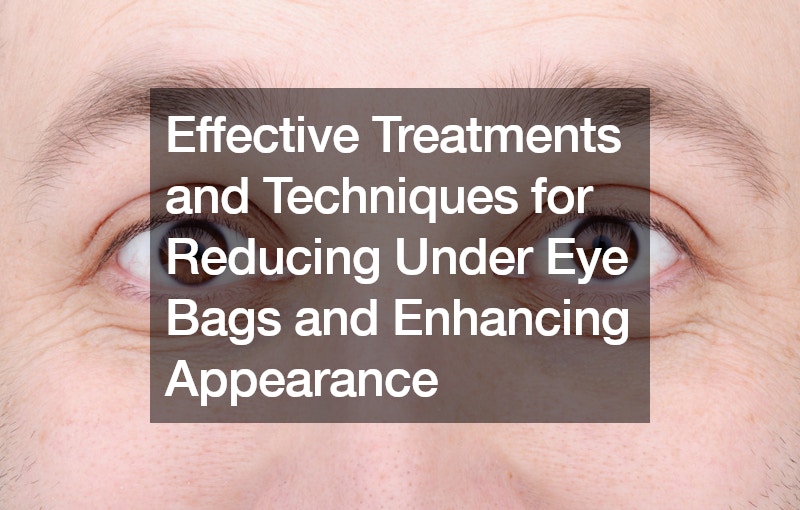The delicate skin under our eyes can often betray our age and fatigue. Under eye bags, those puffy pouches that form beneath the eyes, are a common concern. They can make us look tired, older, and detract from our overall appearance.
While under eye bags are a natural part of the aging process, there are steps you can take to reduce their appearance and achieve a more refreshed look. This article explores the causes of under eye bags and delves into effective eye bag treatments, both surgical and non-surgical.
Understanding the Cause of Under Eye Bags
The primary culprit behind under eye bags is the herniation of fat pads. As we age, the tissues supporting these fat pads weaken, causing them to protrude beneath the thin skin around the eyes.
This loss of volume and elasticity also contributes to the formation of wrinkles and hollowness under the eyes.
Several other factors can worsen under eye bags, including:
- Genetics: Some people are simply more predisposed to under eye bags due to their facial structure and skin type.
- Allergies: Allergies can cause inflammation and fluid retention, leading to puffiness under the eyes.
- Dehydration: When dehydrated, the skin loses its plumpness, making under eye bags more noticeable.
- Sun Damage: Sun exposure damages collagen and elastin, accelerating the formation of wrinkles and under eye bags.
- Lifestyle Habits: Lack of sleep, smoking, and a high-sodium diet can all contribute to under eye puffiness.
Exploring Eye Bag Treatments: Surgical vs. Non-Surgical Options
There are two main categories of eye bag treatments: surgical and non-surgical. The best approach for you will depend on the severity of your under eye bags, your desired results, and your budget.
Surgical Treatments:
- Lower Blepharoplasty: This is the most effective surgical procedure for treating under eye bags. It involves removing or repositioning excess fat and tightening the muscles and skin around the eyes. While highly effective, blepharoplasty is a more invasive procedure with a longer recovery time.
Non-Surgical Treatments:
- Dermal Fillers: Fillers can be used to add volume to the under eye area, creating a smoother transition between the cheek and the under-eye area. This can help to camouflage the appearance of under eye bags.
- Laser Resurfacing: This treatment uses lasers to stimulate collagen production, resulting in tighter, firmer skin under the eyes.
- Radiofrequency Treatments: Similar to laser resurfacing, radiofrequency treatments use radio waves to heat the skin, stimulating collagen and elastin production for a tightening effect.
- Topical Creams: While not a cure-all, some topical creams containing ingredients like retinol or caffeine may help to temporarily reduce puffiness and improve the overall appearance of the under-eye area.
Minimally Invasive Techniques and Multi-Treatment Approach:
For those seeking a less invasive approach, there are a number of minimally-invasive techniques available. These can be particularly appealing for those who are not comfortable with surgery or have a lower budget.
However, it’s important to remember that non-surgical treatments typically offer more subtle results than surgery. Often, the best approach involves a multi-treatment plan, combining different techniques to target various aspects of under eye aging. For example, fillers might be used to address volume loss, while laser resurfacing can improve skin texture and elasticity.
Lifestyle Modifications for Under Eye Care:
In addition to eye bag treatments, incorporating some healthy lifestyle habits into your routine can help prevent and minimize the appearance of under eye bags:
- Prioritize Sleep: Strive to achieve a duration of 7 to 8 hours of restorative sleep every night.
- Hydration is Key: Drink plenty of water throughout the day to keep your skin hydrated and plump.
- Reduce Salt Intake: Excessive sodium intake can lead to fluid retention, causing puffiness under the eyes.
- Limit Alcohol Consumption: Alcohol can dehydrate the skin and worsen the appearance of under eye bags.
- Sun Protection: Wear sunscreen daily to protect the delicate skin around your eyes from sun damage.
- Quit Smoking: Smoking accelerates skin aging and can make under eye bags more prominent.
Choosing the Right Eye Bag Treatment: Consultation is Key
Before embarking on any eye bag treatment, it’s crucial to consult with a board-certified dermatologist or plastic surgeon. They can assess your individual situation, discuss your goals, and recommend the most appropriate treatment options.
During your consultation, be sure to ask about the risks and potential side effects of each treatment, as well as expected results and recovery times. Remember, transparency and open communication are key to achieving a safe and successful outcome.
Conclusion:
Under eye bags are a common cosmetic concern, but they don’t have to define your appearance. Fortunately, there are a range of effective eye bag treatments available. From minimally invasive procedures to lifestyle modifications, you can find a solution that fits your needs and preferences.
Remember, the key to success lies in understanding the cause of your under eye bags and choosing the right treatment approach. By consulting with a qualified professional and adopting healthy habits, you can achieve a more refreshed and youthful look.
.


